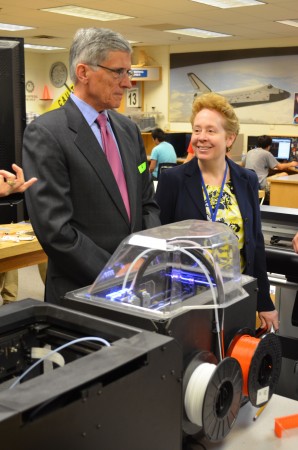
Chairman Wheeler examines a 3-D printer in an engineering classroom at Robinson Secondary School in Fairfax, Va.
I had the pleasure of visiting Robinson Secondary School in Fairfax, Virginia yesterday. The visit confirmed my deep belief that broadband-enabled technologies have the power to revolutionize education – empowering students and teachers. I saw students using laptops to access science lessons and collaborate in the cloud on year-end projects. I saw English as a Second Language students using apps to help learn their new language at their own pace. I talked to students using connected technology, including 3-D printers.
This was my third trip to a school since becoming FCC Chairman, and a consistent theme is emerging from these visits: “connectivity” used to mean connecting to the school; today it means connections to each student. That means that schools need robust Wi-Fi networks. It is wireless broadband connectivity that changes the learning experience and opens new opportunities for students and teachers. What I saw was how Wi-Fi to each student’s desk is the essential component of interactive, personalized instruction tailored to each student’s strengths and weaknesses. I saw how Wi-Fi makes students more productive.
Unfortunately, nearly 60% of schools in America lack sufficient Wi-Fi capability to provide students with 21st Century educational tools. Far too many schools have no Wi-Fi at all. For those that are lucky enough to be connected wirelessly, such networks often don’t meet the capacity needs of students and teachers. I saw this first hand when I visited a school in Oakland, California, where students had to walk around the classroom holding their tablets up in the air until they got a Wi-Fi signal – and when and if they did, the connection was often slow due to a lack of sufficient bandwidth.
Solving this challenge is a national priority. We fully expect coffee shops, hotels, and airplanes to have Wi-Fi. Our schools deserve no less. Unfortunately, the present E-rate program does little to advance Wi-Fi connectivity. Luckily, my fellow Commissioners and I are in a position to act to close the Wi-Fi gap.
The FCC is currently in the process of considering how to modernize the E-Rate program, which since 1998 has provided crucial support to meet the technology needs of schools and libraries. The program has done an excellent job at getting connectivity to schools and libraries. All schools now have access to the Internet, and while more work needs to be done, we estimate that two-thirds of American schools now have fiber connections capable of high-speed delivery.
But the nature of educational connectivity has changed. Earlier on it was revolutionary to simply connect a computer lab. Later, computers made their way into the classroom but were relegated to a place along the back wall. Today we have the technology to expand to laptops or tablets on every student’s desk. Unfortunately, under the current E-Rate rules we are falling far short at meeting the Wi-Fi needs of schools and libraries to fully utilize this technology and the opportunities it enables.
Stakeholders have made clear that improving in-classroom Wi-Fi connectivity is one of, if not the most important connectivity upgrade priority for education technology officers. Yet, in the most recent funding year, E-Rate provided zero dollars for Wi-Fi. That’s right: zero. And in previous years, when funds were available, E-Rate has provided support for internal connections like Wi-Fi to well less than 10 percent of schools and just one percent of libraries. While the overall numbers are appalling, the distribution of these funds hits rural America particularly hard, with only 15% of the funds going to support rural schools and libraries. When the goal is to get Wi-Fi connectivity into every classroom, and to every student, that’s not going to cut it.
Earlier this year I announced that we will invest an additional $2 billion in broadband for schools and libraries through the end of next year. I believe we should put those resources to work now to meet our educators’ overwhelming pent-up demand for upgrading Wi-Fi at our schools and libraries. However, we must act promptly if this opportunity is to be realized beginning next year.
To have an impact in the 2015 school year, the Commission will need to act this summer to adopt new rules modernizing E-Rate, including the program’s mechanism for distributing support. If we don’t move quickly on new rules, we will miss the opportunity for Wi-Fi to have its greatest impact in the coming funding year.
The consequences of delay would be huge.
According to internal staff estimates, allocating an additional $1 billion to Wi-Fi next year without updated program rules will reach fewer than 4 million students, mostly in urban areas. With modernized rules for internal connections, E-Rate could help over 10 million students, including many more in rural areas, connect to Wi-Fi in their classroom. It would also support Wi-Fi into substantially more libraries than in the past.
Today is the one-year anniversary of the President’s ConnectED announcement establishing a five-year goal to connect our nation’s schools to high-capacity broadband. The goals are bold and they are important. We need to rise to the challenge in the near and long-term. Focusing on the Wi-Fi gap now does not suggest that there aren’t other important issues to tackle to ensure that the E-Rate program can sustainably address the technological needs of schools and libraries well into the future.
Every student in America should be able to utilize the wireless digital learning tools I saw making a difference in classrooms. We all know the E-Rate program is in need of modernization. Our choice is whether we help millions more students by acting before the end of summer vacation, or whether we stick with the status quo until the 2016 funding year. I hope my colleagues will agree that the cost of inaction is too high.